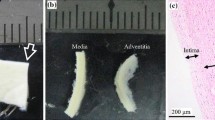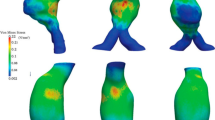Abstract
Knowledge of the biomechanical behavior of abdominal aortic aneurysm (AAA) as compared to nonaneurysmal aorta may provide information on the natural history of this disease. We have performed uniaxial tensile testing of excised human aneurysmal and nonaneurysmal abdominal aortic specimens. A new mathematical model that conforms to the fibrous structure of the vascular tissue was used to quantify the measured elastic response. We determined for each specimen the yield σy and ultimate σu strengths, the separate contribution to total tissue stiffness by elastin (E E) and collagen (E C) fibers, and a collagen recruitment parameter (A), which is a measure of the tortuosity of the collagen fibers. There was no significant difference in any of these mechanical properties between longitudinal and circumferential AAA specimens, nor inE E andE C between longitudinally oriented aneurysmal and normal specimens.A, σy, and σu were all significantly higher for the normal than for the aneurysmal group:A=0.223±0.046versus A=0.091±0.009 (mean ± SEM;p<0.0005), σy versus σy (p<0.05), and σu versus σu (p<0.0005), respectively. Our findings suggest that the AAA tissue is isotropic with respect to these mechanical properties. The observed difference inA between aneurysmal and normal aorta may be due to the complete recruitment and loading of collagen fibers at lower extensions in the former. Our data indicate that AAA rupture may be related to a reduction in tensile strength and that the biomechanical properties of AAA should be considered in assessing the severity of an individual aneurysm.
Similar content being viewed by others
References
Armentano, R. L., J. Levenson, J. G. Barra, E. I. C. Fischer, G. J. Breitbart, R. H. Pichel, and A. Simon. Assessment of elastin and collagen contribution to aortic elasticity in conscious dogs.Am. J. Physiol. 260:H1870-H1877, 1991.
Baxter, B. T., V. A. Davis, D. J. Minion, Y. P. Wang, T. G. Lynch, and B. M. McManus. Abdominal aortic aneurysms are associated with altered matrix proteins of the nonaneurysmal aortic segments.J. Vasc. Surg. 19:797–802, 1994.
Carew, T. E., R. N. Vaishnav, and D. J. Patel. Compressibility of the arterial wall.Circ. Res. 23:61–68, 1968.
Clark, J. M., and S. Glagov. Transmural organization of the arterial media: The lamellar unit revisited.Atherosclerosis 5:19–34, 1985.
Cole, C. W. Highlights of an international workshop on abdominal aortic aneurysms.Can. Med. Assoc. J. 141:393–395, 1989.
Cox, R. H. Passive mechanics and connective tissue composition of canine arteries.Am. J. Physiol. 234:H533-H541, 1978.
Cronenwett, J. L., S. K. Sargent, H. Wall, M. L. Hawkes, D. H. Freeman, B. J. Dain, J. K. Cure, D. B. Walsh, R. M. Zwolak, M. D. McDaniel, and J. R. Schneider. Variables that affect the expansion rate and outcome of small abdominal aortic aneurysms.J. Vasc. Surg. 11:260–268, 1990.
Darling, R. C., R. Carlene, R. N. Messina, D. C. Brewster, and L. W. Ottinger. Autopsy study of unoperated abdominal aortic aneurysms: The case for early resection.Circulation 56:161–164, 1977.
Dobrin, P. B., and R. Mrkvicka. Failure of elastin and collagen as possible critical connective tissue alterations underlying aneurysmal dilation.Cardiovasc. Surg. 2:484–488, 1994.
Dobrin, P. B. Pathophysiology and pathogenesis of aortic aneurysms.Surg. Clin. N. Am. 69:687–703, 1989.
Drangova, M., D. W. Holdsworth, C. J. Boyd, P. J. Dunmore, M. R. Roach, and A. Fenster. Elasticity and geometry measurements of vascular specimens using a high resolution laboratory CT scanner.Physiol. Meas. 14:277–290, 1993.
He, C. M., and M. R. Roach. The composition and mechanical properties of abdominal aortic aneurysms.J. Vasc. Surg. 20:6–13, 1994.
Lanne, T., B. Sonesson, H. Bengtsson, and D. Gustafsson. Diameter and compliance in the male human abdominal aorta: Influence of age and aortic aneurysm.Eur. J. Vasc. Surg. 6:178–184, 1992.
Lehninger, A. L.Biochemistry, New York: Worth Publishers, 1975, 833 pp.
Limet, R., N. Sakalihasan, and A. Albert. Determination of the expansion rate and incidence of rupture of abdominal aortic aneurysm.J. Vasc. Surg. 14:540–548, 1991.
Macsweeny, S. T., G. Young, R.M. Greenhalgh, and J. T. Powell. Mechanical properties of the aneurysmal aorta.Br. J. Surg. 79:1281–1284, 1992.
McGee, G. S., B. T. Baxter, V. P. Shively, R. Chisholm, W. J. McCarthy, W. R. Flinn, J. S. Yao, and W. H. Pearce. Aneurysm or occlusive disease factors determining the clinical course of atherosclerosis of the infrarenal aorta.Surgery 110:370–375, 1991.
Menashi, S., J. S. Campa, R. M. Greenhalgh, and J. T. Powell. Collagen in abdominal aortic aneurysm: Typing, content, and degradation.J. Vasc. Surg. 6:578–582, 1987.
Ouriel, K., R. M. Green, C. Donayree, C. K. Shortell, J. Elliot, and J. A. DeWeese. An evaluation of new methods of expressing aortic aneurysm size: Relationship to rupture.J. Vasc. Surg. 15:12–20, 1992.
Park, J. B., and A. S. Hoffman. Interaction of collagen and smooth muscle cells in aortic biomechanics.Ann. Biomed. Eng. 6:176–171, 1978.
Rizzo, R. J., W. J. McCarthy, S. N. Dixit, M. P. Lilly, V. P. Shively, W. R. Flinn, and J. S. Yao. Collagen types and matrix protein content in human abdominal aortic aneurysms.J. Vasc. Surg. 10:365–373, 1989.
Roach, M. R., and A. C. Burton. The reason for the shape of the distensibility curves of arteries.Can. J. Biochem. Physiol. 35:681–690, 1957.
Samila, Z. J., and S. A. Carter. The effect of age on the unfolding of elastin lamellae and collagen fibers with stretch in human carotid arteries.Can. J. Physiol. Pharmacol. 59: 1050–1057, 1981.
Sherebrin, M. H., J. E. Hegney, and M. R. Roach. Effect of age on the anisotropy of the descending human thoracic aorta determined by uniaxial tensile testing and digestion by NaOH under load.Can. J. Physiol. Pharmacol. 67:871–878, 1989.
Sterpetti, A. V., R. D. Schultz, R. J. Feldhaus, S. E. Cheng, and D. J. Peetz. Factors influencing enlargement rate of small abdominal aortic aneurysms.J. Surg. Res. 43:211–219, 1987.
Sumner, D. S., D. E. Hokanson, and D. E. Strandness. Stress-strain characteristics and collagen-elastin content of abdominal aortic aneurysms.Surg. Gynecol. Obstet 130: 459–466, 1970.
Vaishnav, R. N., J. T. Young, J. S. Janicki, and D. J. Patel. Nonlinear anisotropic elastic properties of the canine aorta.Biophys. J. 12:1008–1027, 1972.
Vawter, D. L. Poisson's ratio and incompressibility.J. Biomech. Eng. 105:194–195, 1983.
Vito, R. P., and J. Hickey. The mechanical properties of soft tissues-II: The elastic response of arterial segments.J. Biomech. 13:951–957, 1980
Vorp, D. A., K. R. Rajagopal, P. J. Smolinski, and H. S. Borovetz. Identification of elastic properties of homogeneous orthotropic vascular segments in distention.J. Biomech. 28:501–512, 1995.
Wolf, Y. G., W. S. Thomas, F. J. Brennan, W. G. Goff, and E. F. Bernstein. Computer topography scanning findings associated with rapid expansion of abdominal aortic aneurysms.J. Vasc. Surg. 20:529–535, 1994.
Author information
Authors and Affiliations
Rights and permissions
About this article
Cite this article
Raghavan, M.L., Webster, M.W. & Vorp, D.A. Ex vivo biomechanical behavior of abdominal aortic aneurysm: Assessment using a new mathematical model. Ann Biomed Eng 24, 573–582 (1996). https://doi.org/10.1007/BF02684226
Received:
Revised:
Accepted:
Issue Date:
DOI: https://doi.org/10.1007/BF02684226




